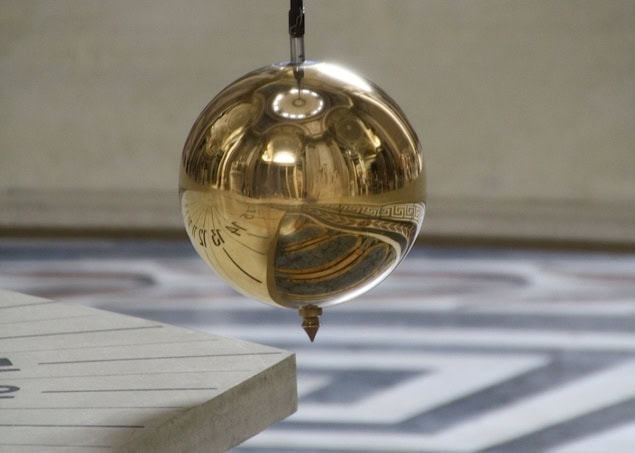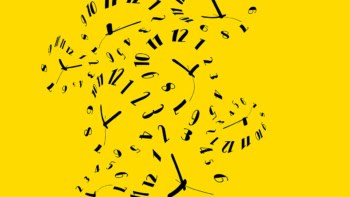Robert P Crease writes in praise of Foucault’s pendulum. A common exhibit in science museums, it reveals the mismatch between human perception and the workings of nature

The first Foucault’s pendulum I ever saw was at the Franklin Institute in Philadelphia, the city where I was born. The pendulum hung in a stairwell. Its wire was attached to the ceiling four stories up, while its silver bob glided silently back and forth over a globe in the floor, with Philadelphia at dead centre. The plane of its oscillation slowly shifted clockwise at an unchanging rate throughout the day: 9.6 º an hour. I’d stare at it, trying to make myself see it was the floor and I that moved – as the sign informed me – and not the pendulum itself. It troubled me that I was never sure I succeeded.
The pendulum’s installation in 1934 was cause for an unusual parade. The wire, which weighed only nine pounds, could not be rolled up but had to be kept straight to prevent stresses that would interfere with its swing. It was therefore carried, stretched out, through the streets of Philadelphia from the manufacturer. The bizarre procession of 11 men carrying a long wire was accompanied by a police escort, and trailed by bemused onlookers and reporters.
The pendulum’s movement was unforgettable, as inexorable a performance as I knew – then or now. The only human influence on it was the museum staff member who started it swinging just before the museum opened at 10 a.m. Once I heard a museum supporter had arranged, as a birthday gift, for his son to start the pendulum one day. How I envied that child. Other kids may have dreamed of tossing out the first pitch at a baseball game. I dreamed of starting a Foucault’s pendulum.
Splendeur magnifique
The story is well known how Jean-Bernard-Léon Foucault discovered that an oscillating pendulum continued to move in the same plane when its mount was turned. He realized that this effect, if magnified enough, could demonstrate the rotation of the Earth. In January 1851 he succeeded, using a pendulum suspended from the vault of his basement. In March of that year, Foucault set up a demonstration at the Panthéon, where it had a “splendeur magnifique”.
Few scientific experiments met such instantaneous fame, and 1851 was the year of the pendulum. Foucault’s pendulums proliferated: Oxford, Dublin, New York, Rio de Janeiro, Ceylon, Rome. Today, hundreds of such pendulums exist all over the world. The pendulum illustrates that every location on this planet is equally in motion – all are to that extent on a par. The United Nations headquarters in New York has a Foucault pendulum in the grand ceremonial staircase of its lobby. The Smithsonian Institution – America’s national museum – once also had a Foucault’s pendulum on display, but it was removed to make way for the restoration project of the Star-spangled Banner, the national symbol. The pendulum now lies in a storage area of the museum.
Foucault’s pendulum fascinates not because it proves the world rotates. All educated Europeans in 1851 knew that the Earth moved, although the evidence was based on astronomical inferences. The pendulum fascinates because it raises puzzling questions about perception itself. Do we really see the pendulum move but know it is really the Earth that moves? Or do we really see the Earth moving? For Foucault, it was the latter, and the pendulum speaks “directly to the eyes”.
Seeing the Earth rotate
Foucault’s remark is philosophically disingenuous: nothing speaks directly to the eyes. Instinctively Cartesian, Foucault felt that what he knew to be true had to be what he saw. Mentally modelling the pendulum oscillating against the background of the solar system, he thought what he saw was the Earth turn.
But perception is more complicated than that. Perceiving what is in motion – and what is at rest – depends on what we take as foreground and what as background. Foucault’s pendulum seems to offer us the experience either of the pendulum turning on the Earth, or of the Earth turning. This either/or resembles French philosopher Maurice Merleau-Ponty’s description and explanation of the familiar experience of being on a stationary train beside another train on a nearby track. When this other train begins to move, we experience either that we are beginning to move or that the other train is beginning to move in the opposite direction. Which sensation we experience, according to Merleau-Ponty, depends on where our perception is invested – in this train or the other – and on what is its background.
So when we see the plane of the pendulum’s oscillation move, we are taking the pendulum as foreground and the surrounding room as background. To “see” the Earth moving, we would have to introduce a different and much bigger background in which the pendulum’s plane of oscillation would be perceived as stationary and the floor and all the surroundings as moving. This could only happen, I have come to think, if the pendulum were mounted not inside but outside, with the heavens as the background. Could one see the Earth turn on a starry night?
The critical point
Foucault’s pendulum is different from other scientific demonstrations because of its size, non-interactive character, and the counterintuitive experience it suggests. It seems to reveal the limitations of human perception in perceiving the workings of nature. Small wonder that Foucault’s pendulum has played a key role in at least two novels, including an eponymously titled best-seller by Umberto Eco, and is the subject of a forthcoming popular book by Amir Aczel, entitled Pendulum: Léon Foucault and the Triumph of Science (2003 Pocket Books/Atria Books).
The Franklin Institute pendulum performed the same way each time I saw it. But it never failed to enthrall me due to its unsettling simplicity. It moved, but stayed the same. It turned, but told me that I was the one who was turning. I looked at it, and what it reflected back was my mobility and that of everything else around me – providing me with a clear and dramatic sense, whose true meaning I sensed I would never entirely fathom, of the deceptions and limits of my own perception and experience.



